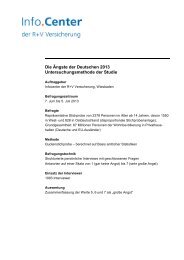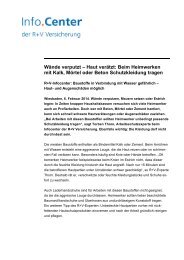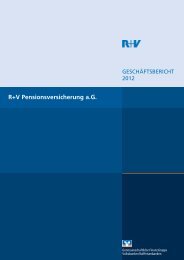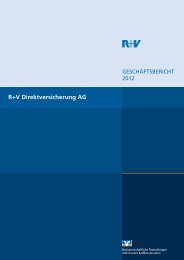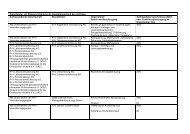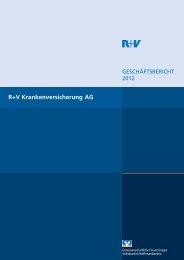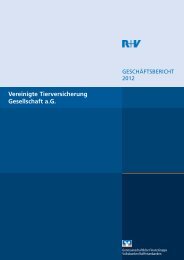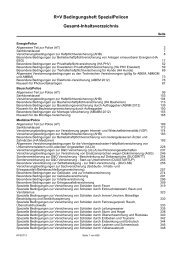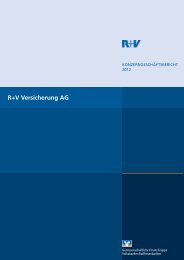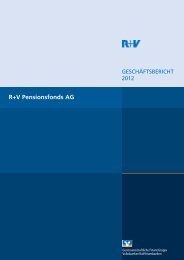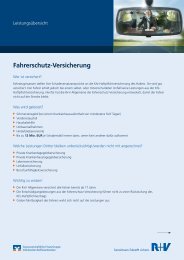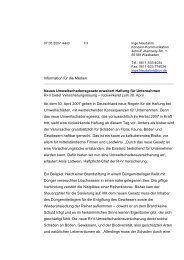R+V Versicherung AG Annual Report
R+V Versicherung AG Annual Report
R+V Versicherung AG Annual Report
Create successful ePaper yourself
Turn your PDF publications into a flip-book with our unique Google optimized e-Paper software.
Asia remained affected by the financial<br />
crises of the 1990s. Brisk competition<br />
among market players kept direct insurance<br />
premiums at a low level. Only in Malaysia<br />
and Thailand were rates in the motor insurance<br />
class adjusted upwards after declining<br />
for many years.<br />
Australia/New Zealand<br />
In Australia, the situation on the most<br />
important sales markets showed no signs<br />
of recovery. At 1.7% of GDP, the balance of<br />
payments deficit reached its lowest point<br />
since 1980. Only the construction industry<br />
contributed more than average to economic<br />
growth thanks to generous government<br />
subsidies.<br />
The insolvency of the insurance group<br />
HIH was the most important event on the<br />
Australian insurance market in the past<br />
fiscal year. However, this also spurred a<br />
recovery in rates and conditions in a number<br />
of insurance classes and speeded up<br />
market consolidation. At the end of the year<br />
under review, certain types of liability cover,<br />
e.g. medical liability, were taken over by the<br />
government, since physicians were unable<br />
to meet the premium increases demanded.<br />
The bush fires which raged in the vicinity<br />
of Sydney from Christmas until around<br />
January 8, 2002 were the largest claim<br />
event for the insurance sector, although this<br />
did not affect us to any significant extent.<br />
New Zealand’s economy was strongly<br />
driven by domestic demand and the real<br />
estate boom. Private consumer spending<br />
rose 1.4% in the last quarter of the year,<br />
corresponding to annual growth of 3.5%.<br />
Demand developed particularly well in the<br />
motor vehicle and real estate sectors.<br />
12<br />
Africa<br />
In African countries economic growth<br />
continued almost unchanged during the<br />
year under review, even though the external<br />
economic shocks took their toll on this<br />
continent too. Africa also felt the effect of<br />
the weak global economy. The declining<br />
raw materials prices had a serious impact<br />
on most countries’ economies. This<br />
development was partly cyclical, as on<br />
the metals market, but in some cases the<br />
changes were much more drastic; coffee<br />
and tobacco prices both collapsed, for<br />
example. As this pushed down exports, the<br />
balance of payments deficit remained high<br />
in most cases. Only oil-producing countries<br />
such as Algeria recorded high surpluses.<br />
Despite the negative development in the<br />
terms of trade and the negative effects this<br />
had on the economy, domestic demand<br />
remained robust. Economic policy progressed<br />
in terms of macroeconomic stability<br />
in almost all countries, with private<br />
investment rising. Countries experiencing<br />
political turbulence were the exception;<br />
output in Zimbabwe, for example, took a<br />
nosedive and inflation skyrocketed.<br />
Africa’s insurance markets were still characterized<br />
by fierce competitive pressure and<br />
political instability in many regions. This<br />
general competitive pressure led to the<br />
merger of a number of direct insurers, principally<br />
in South Africa, which meant that the<br />
number of market players fell. The reinsurance<br />
market followed suit, a trend which<br />
resulted in greater growth opportunities for<br />
the remaining companies.



